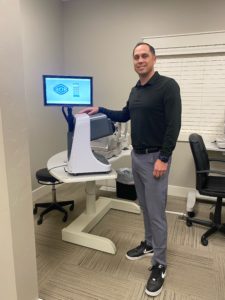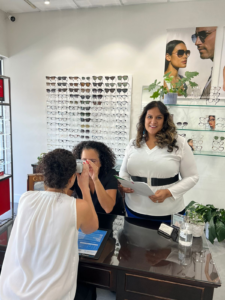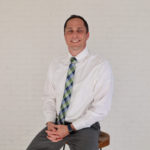
Dr. Hurley with the NMD2 Neurolens measurement device. He says Neurolens has been a game-changer for both his patients and his practice.
A transformative vision and comfort solution.
Sponsored Content
By Jason N. Hurley, OD
and Michelle Jhagroo, OD
Oct. 25, 2023
Your patients deserve the best vision and quality of life possible. Sometimes providing that to them means correcting eye misalignment contributing to headaches and digital eye strain, and even musculoskeletal discomfort. Our practices have found Neurolenses to be an effective way to help these patients achieve the vision and enjoyment of work and life that they deserve. In the process, these lenses have provided our practices with a significant practice—and profitability—builder.
Significant Patient Visual Improvement AND Practice Profitability Improvement
Jason N. Hurley, OD
Eye Care of Rigby
Rigby, Idaho
Neurolens has been a great part of our practice for three years now. On average, we sell 30-40 pairs of Neurolenses per month. Twenty-five percent of our patients who get glasses purchase Neurolenses. This has been hugely beneficial to our practice growth and profitability.
I compare the positive financial impact of Neurolenses to the money that I would have made with a managed-care lens. A single-vision lens with anti-reflective purchased with managed care will generate a $50 dispensing fee, and a progressive dispensing fee will generate $150. With Neurolenses, I will net around $300 for single vision and $400-$450 for a progressive lens. That’s not even including the frame revenue!
I estimate that we will generate an extra $10,000 per month on Neurolenses when compared to a lens purchased with a managed-care plan. This results in an annual NET increase of $120,000 to our practice. When I look at technology and instruments that I could bring into the office, Neurolens is one of the best ROI!
Making Prism Easy
I have never had an interest in doing much prism in my practice. When patients come in and they report diplopia, I know that I am going to spend an extra 20-30 minutes diagnosing and figuring out what and how much prism I am going to put in their glasses. Neurolens makes it easy. It measures the deviation to the 100th prism diopter. The Neurolens Measurement Device then tells me the amount of prism I should use. I go with the Neuorlens Value most of the time as Neurolens has invested a lot of time and money to make sure it is reliable. However, I also like that I have the freedom to tweak the recommended prism if needed.
Another benefit of Neurolenses is that my associate and myself can stay pretty much uniform in our prescribing of prism. This helps our support staff and improves workflow efficiency within the practice.
Letting All Patients Know About New Opportunity for Better Vision & Comfort
I talk to most of my patients about Neurolenses. At the beginning of the exam, when I am doing a case history, I ask the patient to tell me about their symptoms of headaches, neck aches, etc. I want to get on the same page as the patient. I also want to tie their symptoms to their eye misalignment, if we find that they do, in fact, have misalignment.
Even if they are asymptomatic, I want them to know that we help people with the symptoms of eye misalignment, in case any of their friends or family are having this challenge. I want our patients to know that we are the place for both themselves, and everyone they know, to come for solutions that make life better.
Game-Changing Technology with N3
The new Neurolens virtual reality headset (N3) is a game-changer. First of all, it is so cool and high-tech. Who doesn’t want to experience a virtual-reality headset? One area in my office that is small is the pre-testing room. By adding N3 to each exam room, I can eliminate another big instrument in my pre-test room. It will eliminate the bottleneck of patients in my office. I am even going to look at adding a hand-held auto-refractor to speed things up. I love that at the end of the N3 experience it asks the patient if they are interested in Neurolenses. This will save time when explaining this opportunity to the patient and quickly identify those patients who are excited to experience the benefits of Neurolenses.
Future of Vision & Patient Care
Neurolens is the future of lenses. We are addressing our patients’ symptoms and giving them an incredible solution. Headache relief without medications! The new N3 experience is going to be a game-changer. I am so excited to have it in our clinic. Neurolens is about changing lives. I am proud to be part of the Neurolens family, and in turn, help to improve the lives of our patients.

Dr. Jhagroo with an optician and patient in her office. She says that addressing binocular vision concerns with Neurolenses has been a huge patient-pleaser and a significant profitability builder.
Accurately Measuring–and Correcting–Eye Misalignment
Michelle Jhagroo, OD
East Side Vision Center in Pompano Beach, Fla.
Weston Family Eyecare in Davie, Fla.
I have been a part of multiple practices in which we implemented Neurolens. Since implementation at my two current practices, we’ve screened more than 6,000 patients, prescribed more than 3,000 Neurolenses, and around 1,250 have purchased Neurolenses.
Both practices have seen significant growth since launching Neurolens. The initial growth from the first year of implementation is the most significant. However, since launching, we have seen consistent numbers that continue to improve year over year.
Unparalleled Measurement Power for Determining Eye Misalignment
I have always measured eye alignments with the tools taught to me in school, but incorporating Neurolens has allowed me to measure my patients’ phorias with much more accuracy. Much of our testing yields results within half or a quarter of a prism diopter. With the Neurolens Measurement Device, Gen 2 (NMD2), I can be accurate to within 1/100 of a prism diopter! The results are then put into a format that makes it easy to show to patients, so they better understand what this measurement means.
I use the Neurolens Lifestyle Index as a starting point for discussing Neurolenses. Many of the questions on the index are embedded in my case history as I am examining and talking to patients. The combination of discussing these symptoms throughout the exam, and showing the patient how these symptoms may be caused by misalignment, is powerful. Even if a patient is asymptomatic, but the NMD2 shows misalignment, I’ll review it with them and show them how their misalignment could cause symptoms in the future.
A New Tool to Take Care to Next Level
N3 will be transformative for our practice. Not only is it much smaller and more portable than the NMD2, but putting the test in the exam room will heighten the patient experience and make it easier for patients to bring up and discuss the symptoms that they may not have previously associated with their eyes. The easy-to-understand education from this device will help patients make better decisions about their eyewear and will certainly help with eyewear capture rate.
Incorporating N3 will also tee me up nicely to have the conversations I’m already having with patients today. After I have spoken with the patient about their symptoms, I review the results of the NMD2 test. Soon, I’ll be reviewing the results of the N3 experience! I compare the red lines and the green lines and explain how their eyes may be struggling to focus a clear image. I also use a 3D image of the trigeminal nerve to show the neural pathway and why this can trigger “fireworks” anywhere along that pathway.
I explain how the sensory fireworks set off by the misalignment can lead to the strain that causes many of their symptoms, especially headaches, neck pain and dizziness. I also discuss how their eye misalignment can lead to dry eyes, tearing and light sensitivity, while letting them know that we can alleviate the symptoms with methods that may mask them, but we can also address the root causes of those issues with Neurolenses. This conversation will be even more seamless after they’ve gone through the education component of the N3 experience.
Increase Conversion of Progressive Non-Adapts
One of the things I have noticed about implementing Neurolenses is the conversion of previous progressive non-adapts. I almost love it when a patient tells me that they, “Can’t do progressives because they’ve tried it and it didn’t work.” Or: “They made me feel nauseous or dizzy.” 9.999 times out of 10, this person just needed the base in the contoured prism of Neurolenses to help neutralize the expected base out effect of the reading add.
Neurolens gives us a way to provide the visual and comfort solution that has eluded these patients for so long. This greatly enhances both our patients’ capacity to enjoy their lives and our practice’s ability to grow and generate ever-greater profitability.
 Jason N. Hurley, OD, is a partner with Eye Care of Rigby in Rigby, Idaho. To contact him: eyecareofrigby@yahoo.com
Jason N. Hurley, OD, is a partner with Eye Care of Rigby in Rigby, Idaho. To contact him: eyecareofrigby@yahoo.com
 Michelle Jhagroo, OD, practices at East Side Vision Center in Pompano Beach, Fla., and Weston Family Eyecare in Davie, Fla. She is also affiliated with The Florida Heiken Children’s Vision Program, a subsidiary of Miami Lighthouse for the Blind and Visually Impaired. To contact her: mjhagroo@gmail.com.
Michelle Jhagroo, OD, practices at East Side Vision Center in Pompano Beach, Fla., and Weston Family Eyecare in Davie, Fla. She is also affiliated with The Florida Heiken Children’s Vision Program, a subsidiary of Miami Lighthouse for the Blind and Visually Impaired. To contact her: mjhagroo@gmail.com.

























